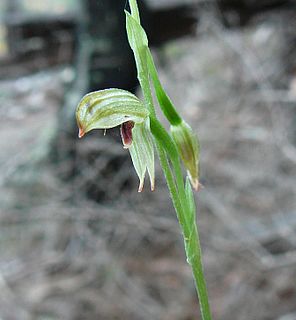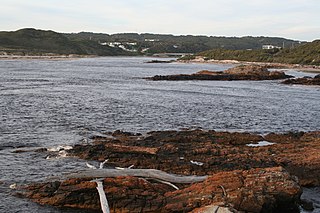
Pterostylis curta, commonly known as the blunt greenhood, is a species of orchid found in south-eastern Australia, Lord Howe Island and New Caledonia. It has a rosette of leaves at its base and a single white and green, forward leaning flower with a brown tip and a twisted labellum.

Pterostylis grandiflora, commonly known as the cobra greenhood or superb greenhood, is a species of orchid endemic to south-eastern Australia. As with similar orchids, the flowering plants differ from those which are not flowering. The non-flowering plants have a rosette of leaves but the flowering plants lack a rosette and have a single flower with leaves on the flowering spike. This greenhood has a green and white, striped flower with deep red-brown markings especially on its "galea", and a sharply pointed dorsal sepal.

Pterostylis atrans, commonly known as the dark-tip greenhood or blunt-tongue greenhood, is a species of orchid endemic to south-eastern Australia. As with similar greenhoods, plants in flower differ from those that are not flowering. The non-flowering plants have a rosette of leaves flat on the ground, but the plants in flower have a single flower with leaves on the flowering spike. In this species, the flower is green and reddish brown with a protruding sinus and small club-like tips on the ends of the lateral sepals.

Pterostylis tunstallii, commonly known as Tunstall's greenhood or granite greenhood is a plant in the orchid family Orchidaceae and is endemic to south-eastern Australia. Flowering plants have up to ten transparent green flowers which have a dark brown, insect-like labellum with a blackish "head". Non-flowering plants have a rosette of leaves on a short stalk but flowering plants lack the rosette, instead having five to eight stem leaves.

Pterostylis vittata, commonly known as the banded greenhood or green-banded greenhood, is a plant in the orchid family Orchidaceae and is endemic to the south-west of Western Australia. The plants either have a rosette of leaves on a short stalk in the years when not flowering or stem leaves on a flowering spike. When flowering, it has up to about twenty five flowers which are translucent green with darker green stripes. It was formerly thought to occur in South Australia and Victoria but those collections are now thought to be of Pterostylis sanguinea.

Pterostylis williamsonii, commonly known as the brown-lip leafy greenhood, is a plant in the orchid family Orchidaceae and is endemic to Tasmania. Flowering plants have up to seven transparent green flowers with darker green and brown bands and a hairy, insect-like labellum with a blackish stripe. Non-flowering plants have a rosette of leaves on a short stalk but flowering plants lack the rosette, instead having five to seven stem leaves.
Pterostylis alata, commonly known as the striped greenhood, is a species of orchid endemic to Tasmania. As with similar orchids, the flowering plants differ from those which are not flowering. The non-flowering plants have a rosette of leaves but the flowering plants have a single flower with leaves on the flowering spike. This greenhood has a white flower with prominent dark green stripes and a sharply pointed, brown-tipped dorsal sepal. Similar greenhoods growing on the Australian mainland were formerly known as Pterostylis alata but are now given the name Pterostylis striata.

Pterostylis striata, commonly known as the mainland striped greenhood, is a species of orchid endemic to south-eastern mainland Australia. As with similar orchids, the flowering plants differ from those which are not flowering. The non-flowering plants have a rosette of leaves but the flowering plants have a single flower with leaves on the flowering spike. This greenhood has a white flower with prominent dark green stripes and a brown-tipped dorsal sepal with a thread-like tip. Mainland striped greenhoods were formerly described as Pterostylis alata but that species is now recognised as a Tasmanian endemic.
Pterostylis aphylla, commonly known as the leafless greenhood, is a species of orchid endemic to Tasmania. As with similar greenhoods, the flowering plants differ from those which are not flowering. The non-flowering plants have a rosette of leaves flat on the ground but in this species, the flowering plants have a single green and white flower with a brown tip and lack leaves apart from a few small scales.
Pterostylis atriola, commonly known as the snug greenhood, is a species of orchid endemic to Tasmania. As with similar orchids, the flowering plants differ from those which are not flowering. The non-flowering plants only have a rosette of leaves but the flowering plants have one or two rosettes on growths from the base and up to ten small, dark green, white and brown flowers on a relatively tall flowering spike. It is a rare species, only known from four widely separated populations.
Pterostylis commutata, commonly known as the midland rustyhood is a plant in the orchid family Orchidaceae and is endemic to Tasmania. It has a rosette of leaves near its base and up to five translucent white and green flowers with a hairy, insect-like labellum. It is only found in a small area near Tunbridge and Ross.
Pterostylis dubia, commonly known as the blue-tongued greenhood, is a plant in the orchid family Orchidaceae and is endemic to Tasmania. It has a rosette of fleshy leaves at its base and a dark green and white flower with narrow petals and a dark blue-green labellum.
Pterostylis pratensis, commonly known as the Liawenee greenhood, is a plant in the orchid family Orchidaceae and is endemic to Tasmania. Both flowering and non-flowering plants have a rosette of leaves lying flat on the ground. Flowering plants have up to twelve crowded white flowers with prominent green stripes. This greenhood only grows in low, exposed subalpine tussock grassland.
Pterostylis tanypoda, commonly known as the swan greenhood, is a species of greenhood orchid endemic to New Zealand. Both flowering and non-flowering plants have a rosette of leaves lying flat on the ground and flowering plants have up to seven crowded, inconspicuous bluish-green and white-striped flowers.

Pterostylis torquata, commonly known as the collared greenhood, is a species of orchid endemic to New South Wales. As with similar greenhoods, the flowering plants differ from those which are not flowering. The non-flowering plants have a rosette of leaves flat on the ground but the flowering plants have a single flower with leaves on the flowering stem. This greenhood has a white flower with dark green and dark brown markings, although in some areas, the flowers lack the brown markings. The sinus between the lateral sepals is platform-like.
Pterostylis uliginosa, commonly known as the marsh greenhood, is a species of orchid endemic to south-eastern Australia. As with similar orchids, the flowering plants differ from those which are not flowering. The non-flowering plants have a rosette of leaves but the flowering plants lack a rosette at the base but have up to three rosettes on lateral growths and up to seven small green and white flowers. This species only grows in wet places, usually where there is free water. There are usually only two or three flowers per plant, and only one or two are open at a time.
Pterostylis wapstrarum, commonly known as the fleshy greenhood, is a plant in the orchid family Orchidaceae and is endemic to Tasmania. Both flowering and non-flowering plants have a rosette of leaves lying flat on the ground and flowering plants have up to fifteen crowded green flowers with darker green veins.
Pterostylis ziegeleri, commonly known as the Cape Portland greenhood, is a plant in the orchid family Orchidaceae and is endemic to Tasmania. Both flowering and non-flowering plants have a rosette of leaves lying flat on the ground and flowering plants have up to eight crowded translucent, pale green flowers with darker green veins.
Pterostylis exserta, commonly known as the exserted rufous greenhood, is a species of orchid endemic to the south-west of Western Australia. Both flowering and non-flowering plants have a large rosette of leaves flat on the ground and flowering plants have up to seven pale, transparent green and white flowers with brownish lines.
Pterostylis flavovirens, commonly known as the coastal banded greenhood, is a plant in the orchid family Orchidaceae that is endemic to South Australia. As with other similar orchids, non-flowering plants differ from those in flower. Flowering plants have up to seven pale to translucent green flowers with darker green stripes. The flowers have an insect-like labellum which is yellowish green with a slightly darker green stripe along its centre. Non-flowering plants have a rosette of leaves on a stalk, but flowering plants lack the rosette, instead having three to six stem leaves.

















